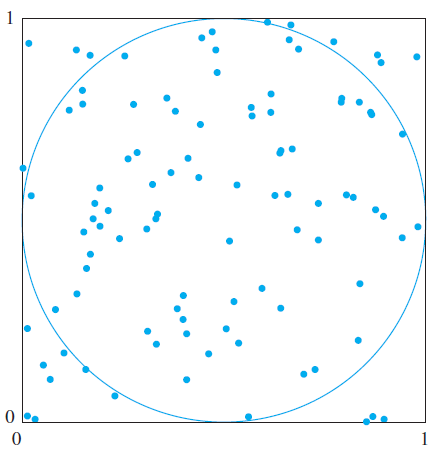Estimating the value of . The following figure suggests how to estimate the value of with
Question:
Estimating the value of π. The following figure suggests how to estimate the value of π with a simulation. In the figure, a circle with area equal to π/4 is inscribed in a square whose area is equal to 1. One hundred points have been randomly chosen from within the square. The probability that a point is inside the circle is equal to the fraction of the area of the square that is taken up by the circle, which is π/4. We can therefore estimate the value of π/4 by counting the number of points inside the circle, which is 79, and dividing by the total number of points, which is 100, to obtain the estimate π/4 ≈ 0.79. From this we conclude that π ≈ 4(0.79) = 3.16. This exercise presents a simulation experiment that is designed to estimate the value of π by generating 1000 points in the unit square.

a. Generate 1000 x coordinates X*1, . . ., X*1000. Use the uniform distribution with minimum value 0 and maximum value 1.
b. Generate 1000 y coordinates Y*1, . . ., Y*1000, again using the uniform distribution with minimum value 0 and maximum value 1.
c. Each point (X*i, Y*i ) is inside the circle if its distance from the center (0.5, 0.5) is less than 0.5. For each pair (X*i, Y*i ), determine whether its distance from the center is less than 0.5. This can be done by computing the value (X*i − 0.5)2 + (Y*i − 0.5)2, which is the squared distance, and determining whether it is less than 0.25.
d. How many of the points are inside the circle? What is your estimate of π? With only 1000 points, it is not unlikely for your estimate to be off by as much as 0.05 or more. A simulation with 10,000 or 100,000 points is much more likely to provide an estimate that is very close to the true value.
DistributionThe word "distribution" has several meanings in the financial world, most of them pertaining to the payment of assets from a fund, account, or individual security to an investor or beneficiary. Retirement account distributions are among the most...
Step by Step Answer:






